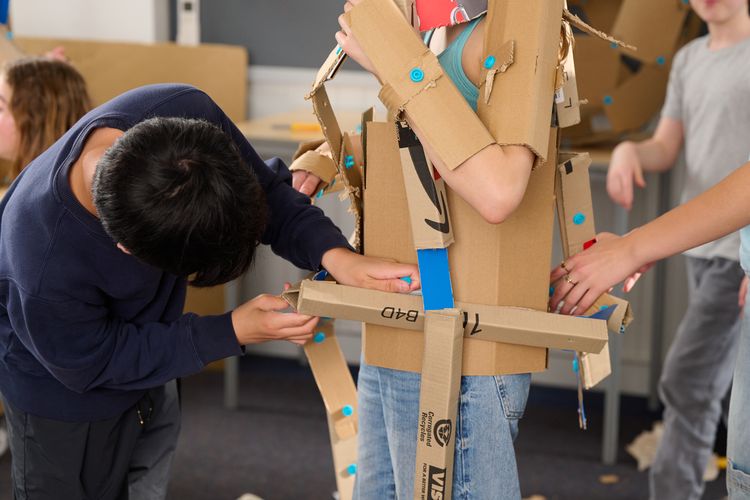
Bring a character to life!
Inspire your students to be designers on a mission to create a costume that transforms the wearer into a memorable and recognisable character, first responder, inventor, or even a superhero!
Subjects
English Language Arts, STEAM, Science, Design and Technology, Social Studies, History
Objectives
Preparation
Materials
Makedo Invent Kit
Upcycled cardboard
Cardboard tubes
Resource: Design Thinking Process
Unsure of which cardboard to use? Read our guide here.
Activity
The Design Challenge
Pose the following scenario:
You are a costume designer on a mission to bring a famous character to life! Your challenge is to create a fun, wearable costume out of cardboard that will transform a friend into a famous book character, historical figure, first responder, inventor, or superhero. Make sure you use creativity, include key character details, and work as a team to make your costume wearable and your character easily identifiable.
Your Goal: Design and build a creative, recognisable costume using cardboard and Makedo. Your costume should reflect key traits, symbols, or outfits of a chosen book character, historical figure, or imaginative superhero.
Your Role: You are a costume designer tasked with creating a cardboard costume that transforms a friend into a memorable character.
Your Audience: You will present your transformation to a board of costume judges (e.g. your classmates and teacher). These judges will evaluate how well your design choices communicate your chosen character’s identity.
The Scenario: Your class task is to make a living museum by recreating famous characters out of cardboard and other upcycled materials. It’s your job to make sure that when someone puts on the cardboard costume you’ve made, they are instantly recognisable as the famous character.
The Product: A wearable and functional costume that brings your chosen character to life by focusing on key traits.
Reflection
Journal Prompts
Have the students journal their responses to the following prompts:
Who is your chosen character and why did you pick them?
What are some key traits or items you used to represent this character?
What aspects of your design are you most pleased with?
How did you and your partner work together? What went well? What could you improve upon?
After presenting and hearing feedback from your classmates, would you change anything about your design if you could do it again?
Facilitation Tips
Guiding the Design Process
Design Process: Guide students through the design process. Research, sketch, plan, iterate, reiterate as needed, share!
Maker Budget: Set up a materials station and give students a maker budget. Make budget planning part of the process!
Make time for reflection. Build in time for students to journal and discuss their process, as this is where learning occurs, and reflection provides students with time to synthesise their learning.
Share the awesome! Host a costume parade to share costumes outside of your classroom!
Extensions
Take It Further
Ask students to create costumes with wearable technology in line with a theme like robots, dinosaurs, or animals!
Students could create a character with key features and then write a story featuring their creation! And maybe even act it out for the class!
Make it a math lesson and have students calculate the surface area of their costumes.
Further Resources
Alignment to Standards
These standards are highly relevant to this activity. For a complete list, please refer to the framework websites. This list can be tailored for your class.


